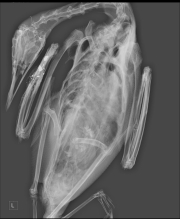A dead adult loon was discovered on Bradley Lake in Andover on August 28 by a construction crew working at a lakefront property. The loon was collected by New Hampshire Fish & Game Region 2 Conservation Officer Jonathan Demler, who then transferred it to the Loon Preservation Committee (LPC). An initial radiograph at Meadow Pond Animal Hospital in Moultonborough showed a gunshot wound on the right wing. A necropsy performed at the Cummings School of Veterinary Medicine at Tufts University in late October confirmed that the trauma from the gunshot wound was the cause of death. The loon also had an elevated lead concentration in its tissue fluid from the lead bullet and a severe fungal infection in its air sacs, most likely a complication from the gunshot wound.

Loons are a state-threatened species and are protected under the Migratory Bird Treaty Act. From 1989-2015, two percent (2%) of dead adult loons collected were the result of gunshot wounds, including, most recently, two adult loons that were shot in the spring of 2014. Forty-four percent (44%) of dead adult loons collected during the same time period died of ingested lead fishing tackle. Human-caused mortalities, including lead tackle, gunshot, fishing line entanglement, boat collisions, and other results of human activity, account for a minimum of 65% of collected adult loon mortalities. Because loons do not breed until 6-7 years of age and have low reproductive success, the loss of so many adults from these preventable causes of mortality has inhibited the recovery of loons in New Hampshire. The loss of an adult loon may also result in the loss of that loon’s nest or chick, further negatively impacting the population.
LPC has worked with New Hampshire Fish and Game and the New Hampshire Legislature to reduce loon mortality, including leading efforts to effect legislation restricting the sale and use of lead fishing sinkers and lead-headed jigs weighing 1 oz. or less in New Hampshire. This legislation was fully enacted June 1, 2016, and LPC is encouraged to see preliminary signs of a reduction in lead tackle mortalities since the new legislation took effect. “This is a critical time to strengthen the state’s loon population,” said Harry Vogel, Senior Biologist/Executive Director of the Loon Preservation Committee. “Loons are a northern species close to the southern limit of their breeding range here in New Hampshire, and the effects of increasing temperatures and rain events are going to increasingly challenge our loons in the future. We need to protect loons from preventable human causes of mortality, like gunshot and lead tackle. The loss of any adult loon impairs the recovery of the species in our state.” LPC and New Hampshire Department of Fish and Game have partnered to educate anglers about the harmful effects of lead fishing tackle to loons and other wildlife. For more information on New Hampshire’s lead tackle legislation and non-toxic alternatives to lead fishing tackle, please visit FishLeadFree.org.
The Loon Preservation Committee (Loon.org) monitors loons throughout the state as part of its mission to restore and maintain a healthy population of loons in New Hampshire; to monitor the health and productivity of loon populations as sentinels of environmental quality; and to promote a greater understanding of loons and the natural world.